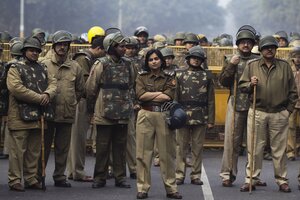India gang rape: why women are needed as justice officials
Mass protests in India after a vicious gang rape of a female student help put a spotlight on countries that need to have more women police and judges. Antirape laws are not enough.

Indian police stand guard in front of a barricade as protesters march towards them during a Dec. 27 protest against a recent gang rape of a young woman in a moving bus in New Delhi. Prime Minister Manmohan Singh pledged to protect women while the young rape victim was flown to Singapore for treatment.
AP Photo
On paper, women today have far more legal protections than 50 years ago. More than half of the world’s countries have written gender equality into their constitutions. But the brutal rape of a female student in India has thrown a global spotlight on the need to put legal norms for women into practice.
For two weeks after the gang rape on Dec. 16, thousands of Indians have protested in New Delhi over the indifference of police and judges to the high number of incidents of rape. Legislators are now scrambling to pass antirape reforms. They have far to go.
India’s conviction rate in rape cases is no more than 26 percent. And that’s just for reported rapes. In a key measure of official insensitivity to violence against woman, only 7 percent of police officers are women. And a 1996 survey of judges in India found that 68 percent of them said provocative clothing is an invitation to rape.
One of the best ways to deter rape is to make it easier for women to report it, especially in a patriarchal and traditional society like India. Yet in a survey of 57 countries, only 1 in 10 women who say they experienced a sexual assault actually reported it.
Studies show that the reporting of sex crimes by women increases if female police officers are available to rape victims. The main reason is that it helps lessen the shame and stigma often felt by a female rape victim. And it allows for more comfort and consoling of the innocent.
Up and down the justice system more women are needed to deal with female-related crimes. Worldwide, only 9 percent of police and 27 percent of judges are women.
Many countries have become models of reform in how to deal with rape. Brazil set up women-only police stations in 1985, a practice now common in Latin America. Countries from Fiji to Pakistan provide special legal advice to women to help them through the courts. In parts of Africa, judges specializing in sex-crime cases travel to remote rural areas. In many countries, health workers are given special training in how to treat sexual-abuse victims.
According to a 2011 United Nations report on women, the justice system in most countries still needs to change its practices toward women. East Timor, for example, has only one doctor trained to collect evidence in rape cases.
“Although there is further to go, laws on violence against women are beginning to establish the kind of clear mandates and procedures that are needed to drive implementation and improve women’s access to justice,” stated the UN report.
The certainty of punishment for rape and the care that is given to rape victims will help curb rape. Equality for women means lifting their fears of rape through equality of treatment by law enforcement officials.

